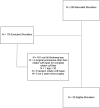Full-thickness arthroscopic rotator cuff repair demonstrates low repair failure rates and high return to sport rates in patients aged 30 years and under at 9-year follow-up: A single-center case series
- PMID: 39811680
- PMCID: PMC11726496
- DOI: 10.1177/17585732241312192
Full-thickness arthroscopic rotator cuff repair demonstrates low repair failure rates and high return to sport rates in patients aged 30 years and under at 9-year follow-up: A single-center case series
Abstract
Purpose: The purpose of this study is to assess the long-term clinical complications, outcomes, and return to sport (RTS) rates in patients aged 30 or younger with a primary full-thickness arthroscopic rotator cuff repair (ARCR).
Methods: All patients who underwent a primary full-thickness ARCR at age 30 years or younger from 2003 to 2021 with a minimum of a 2-year follow-up were included. Complications, repeat surgeries, and return to sport rates were collected.
Results: 32 patients underwent primary full-thickness rotator cuff repair with a mean follow-up of 9.3[2.7-17.9] years. 5(15.6%) patients had postoperative shoulder stiffness, and persistent postoperative shoulder pain was reported in 4(12.5%) patients. There were 3(9.4%) reported repair failures, with complete rotator cuff re-tears reported in 2(6.3%) shoulders and partial rotator cuff re-tear in 1(3.1%) shoulder. There were 4(12.5%) reoperations at an average of 8.7[0.65-22.7] months from primary rotator cuff repair and 2(6.3%) revision rotator cuff repairs. There was a 78.6% RTS rate at an average of 6.5[4-12] months postoperatively, with 8(72.7%) athletes returning to the sport at the same level they initially participated in pre-surgery.
Conclusion: Patients aged 30 and under who underwent full-thickness ARCR experienced promising clinical outcomes at an average 9-year follow-up.
Study design: Retrospective Case Series; Level of Evidence, 4.
Keywords: Arthroscopic rotator cuff repair; full-thickness rotator cuff tear; outcomes; under 30.
© The Author(s) 2025.
Figures
References
-
- Maruvada S, Madrazo-Ibarra A, Varacallo M. Anatomy, Rotator Cuff. In: StatPearls. Treasure Island (FL): StatPearls Publishing, http://www.ncbi.nlm.nih.gov/books/NBK441844/ (2024, accessed 30 April 2024).
-
- Tashjian RZ. Epidemiology, natural history, and indications for treatment of rotator cuff tears. Clin Sports Med 2012; 31: 589–604. - PubMed
-
- May T, Garmel GM. Rotator Cuff injury. In: StatPearls. Treasure Island (FL): StatPearls Publishing, http://www.ncbi.nlm.nih.gov/books/NBK547664/ (2024, accessed 30 April 2024).
-
- Patel M, Amini MH. Management of acute rotator cuff tears. Orthop Clin North Am 2022; 53: 69–76. - PubMed
LinkOut - more resources
Full Text Sources

